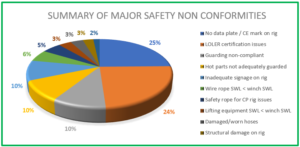Authors
Julian Lovell, Managing Director, Equipe Group
Jon Rayner, Director SH&E, EUR – UK & Ireland, AECOM
Introduction
Recently there have been a number of serious incidents/accidents involving drilling machines and recent site safety audits and inspections have discovered poorly maintained machinery and lack of demonstratable operative competency. This article explores the risk to safety posed by plant and in particular the compliance with health and safety legislation and guidance relating to drilling machines which are used on almost every geotechnical project whether that be a dynamic sampling machine or rotary piling machine.
Legislative Framework
There are numerous pieces of health, safety and environmental legislation which apply to ground investigations, but the control of the common safety aspects of construction work, of which ground investigation is undeniably part of, relies heavily upon the implementation of and compliance to the Construction (Design and Management) Regulations, 2015 (CDM).
HSE also publishes guidance to help people to understand what the law says, to help duty holders comply with the law and to give technical advice. HSE guidance, which is generally not specific to a particular industry and further guidance including British Standards and industry specific guidance, may be used by the regulator and the courts to demonstrate that good practice has been followed.
This guidance is not compulsory, but the HSE advises that if you do follow it, you will normally be doing enough to comply with the law. If an incident occurs, health and safety inspectors and prosecutors will check for compliance and duty holders may well be found liable of a torte of negligence under the Health and Safety at Work Act 1974 and face a financial penalty and or a custodial sentence. If an incident occurs from a known and documented risk(s), then this will be looked upon unfavourably, if it is demonstrated as being ‘reasonably forseeable’ risks, which have not been managed and monitored sufficiently.
The operation of drilling machines is governed by a number of specific legislative statutes and guidance most notably the Machinery Safety Directive, Provision and Use of Work Equipment Regulations (PUWER) and BS EN 16228 – Drill Rig Safety. The obligations under these parts of the legislative framework almost entirely rest with the manufacturers, buyers and users of the equipment (the Contractors). However, Clients and Designers must not forget their obligations under CDM as they also have a duty to engage with competent Contractors and must make suitable arrangements for managing a project, including the allocation of sufficient time and other resources. In respect of Client duties, the regulations clarify that arrangements are suitable if they ensure that the construction work can be carried out, so far as is reasonably practicable, without risks to the health or safety of any person affected by the project.
The Knowns
The AGS and BDA Safety Working Groups have published a number of safety guidance, safety alerts and Client’s guide documents to bring these safety issues to the attention of the industry. The AGS is also currently preparing a number of Client Guides which will provide guidance on known safety issues relating to ground investigation activities and in particular the machines and methodologies being used.
The data for these documents have been derived from a programme of independent post-delivery (pre-use) inspections commissioned over the past three years principally by AECOM and delivered by Equipe, which itself resulted in production of the AECOM Drilling Operating Standards Industry Working Group (DOSIWiG) document series. It is these DOSIWiG documents which will form the basis of the AGS Client Guides.
A total of 114 inspections were carried out over a period from September 2019 to November 2021 and involved 18 different ground investigation contractors. The graphic below provides a summary of the key safety non-conformities found during the inspections.
Throughout this programme, the major safety issues have remained consistent; a lack of awareness of legislative requirements, inadequate guarding of both the drill string and hot parts and under-rated or damaged lifting accessories including wire rope defects. The programme has determined that those employing, managing and operating the machines have little awareness of what full machinery compliance looks like. It has also identified a general poor understanding of what is required to fully comply with PUWER & LOLER (where applied) by those responsible for daily compliance inspection of the machines, with the industry often reliant too heavily on the manufacturers of the machines.
The Unknowns
The data highlighting these safety issues have been obtained from large projects and from organisations who already implement an approved subcontractors audit process. Whilst the Client’s competency checks and onboarding process are vigorous, these non-conformities would not have been identified without the benefit of the independent pre-use inspections. So how many non-compliant machines are in use today?
The independent pre-use inspection initiative has provided invaluable insight and, more importantly, data which can be analysed and used to create targeted guidance for the industry. The data suggests some improvement, but do the ongoing and consistent trends suggest that these issues are still not being seen to be significant by those appointing, engaging and managing drilling contractors?
The reason for the continuing lack of compliance is not clear but anecdotal evidence suggests that perhaps it is due to these non-conformities not being seen to be serious or a potential causal effect for incidents/accidents. Many parts of the industry believe that when a wire rope fails, it will ‘fail to safe’ as any load being carried will simply drop safely to the bottom of the hole. Recent site accidents would indicate otherwise. Likewise, a belief exists that the lack of paperwork does not inherently make a site or equipment unsafe, but lack of structured and recorded checking can allow unsafe equipment and operations to continue.
These attitudes are clear signs of a juvenile industry safety culture which is not learning the lessons from the wider construction industry. Time and effort are being spent on discrediting safety practices or identifying reasoning why they shouldn’t be applied to the ground investigation industry, rather than adopting cross industry best practise. Why?
Time, money and effort should be balanced against risk, at least this is what the Health and Safety at Work Act 1974 tells us. However, when there is an inherent race to the bottom to win work, anything which adds cost is challenged by the industry, as the industry is governed by those competing for the work.
Is this to the benefit of the Clients? Clients will follow current industry guidance, setting these safety standards within specifications, project standards, etc. under the assumption that this constitutes best practice and will ensure a safe project. The reality is that these standards are watered down to keep the industry lean and value for money in the eyes of those appointing them, while retaining risk to those engaging in the work activities.
Summary
Looking past the industry guidance, it is clear from the data that not enough is being done to ensure safety within the industry, with 52% of drilling machines still being deemed not fit for use. The AECOM pre-use inspection programme provides evidence that there are significant problems regarding compliance of drilling machinery legislation. Without such a programme these drilling machines would have been defective when in use – machines which require operatives to work continuously in close proximity to them.
Whilst Contractors will continue to carry the largest obligations regarding compliance, Client’s also have obligations under CDM 2015.
Clause 30 – ‘the client is required to make suitable arrangements for managing the project so that health, safety and welfare is secured.’ and
Clause 31 (f) – ‘Arrangements should include setting out the means to ensure that the health and safety performance of designers and contractors is maintained throughout’.
An independent pre-use inspection programme is a tool which can be used by Clients and Designers to meet obligations applicable to the safe use of plant and machinery and should, if adopted, lead to significant improvements of compliance and therefore safety within these areas.
Clients can greatly help the industry to manage and maintain the machinery safety by instigating this or a similar approach on their projects. This will ultimately reduce safety accident and incidents, and in turn reduce harm, project delays, maintain client reputation and increase productivity by the use of good quality, fully compliant machinery.

